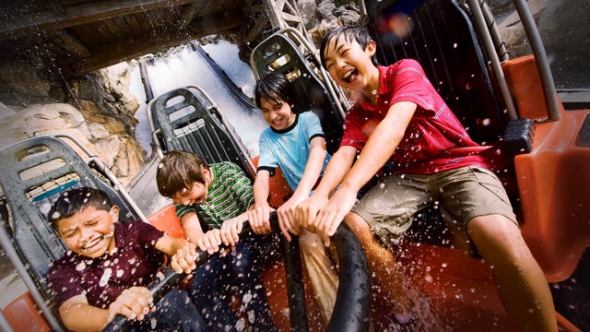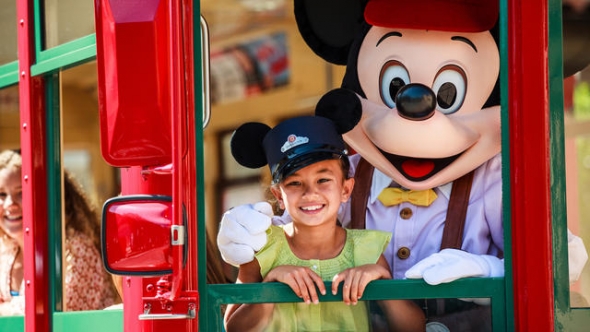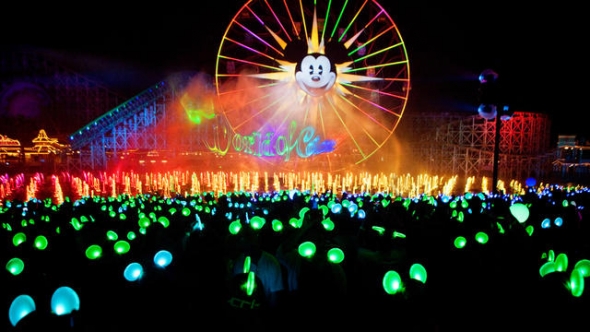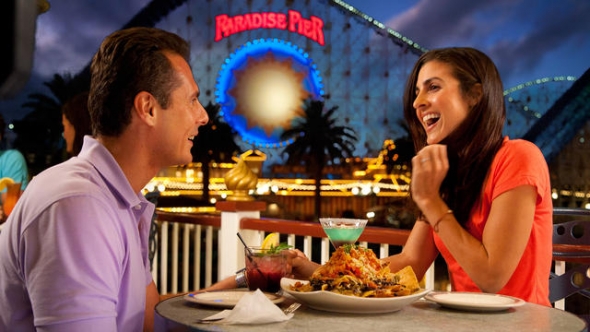The wrong motivations
Image: Disney
In addition to trying to lessen humanity’s appreciation of nature, Eisner had two other goals with Disney California Adventure. He wanted to boost attendance at Disneyland. In tandem with this, he also wanted to expand the revenue guests spent during the average vacation to the most popular theme park in Los Angeles. Roughly 40 years after its debut, Disneyland had rightfully taken its place as one of the iconic tourist attractions on the West Coast.
The “problem” Disney faced, if it’s fair to describe the issue as such, is that everyone had a comfort level with Disneyland. During years when they added no major attractions or events, potential guests felt little incentive to visit. Disneyland was a part of the heritage and culture of most California residents, but it lacked urgency. Due to the space limitations of the park, it also featured a finite number of attractions.
With so many guide books offering suggestions on how to maximize one’s time at Disneyland, most tourists approached a theme park visit with hit-and-run tactics. They had plans on how to do everything in the shortest number of days, with the introduction of FastPass in 1999 only magnifying their ability to do so. Eisner couldn’t anticipate that in the mid-‘90s, of course, but he was aware of how little of a family’s vacation budget Disney captured per visit.
At its core, Disney California Adventure represented the most cynical of theme park endeavors. If Disneyland operated like Walt Disney World, attracting and keeping guests for the body of a week, Disney California Adventure wouldn’t exist. It was a purely capitalist endeavor. That’s on Eisner, who shared many of the same business skills as Walt Disney but few of the people skills. He failed to anticipate how much Disney zealots needed to feel respected during the vacation planning process. All he cared about was emptying their pockets once they arrived.
Disney California Adventure’s early days were the logical conclusion of such a simplistic business decision. Every decision came tethered to an unspoken expectation. Anything that didn’t cause guests to stay longer and spend more money was a Bad Idea, which is the polar opposite of how Walt Disney ran the company. Commerce ruled the planning phase of the second gate at Disneyland.
The right results
Image: Disney
Don’t misunderstand me, though. Even though Eisner obsessed on the bottom line to the detriment of early attractions at Disney California Adventure, his logic was sound. In 1994, Disneyland attracted 10.3 million guests. A large percentage of them were California residents, and any theme park operator can tell you that locals visit more often while spending less.
To breathe new life into the Happiest Place on Earth, Eisner needed to shake things up. He needed to boost the revenue stream at Disney before some shady corporate liquidator acquired the company and then stripped it for parts. This danger existed every day throughout the first half of Eisner’s tenure as Disney CEO. No matter what you think of him as a person, I can say that in my time as a financial journalist, I’ve come across multiple market analysts who believe that Eisner saved the company. Roy E. Disney might roll over in his grave at the thought of that, but here’s a stat that reinforces the belief. In 1984, the year he took over the company, Disney claimed revenue of $1.5 billion. During 2004, the last full year he served as company chief, it was $30.8 billion. He also boosted Disney’s market value from $1.9 billion to $57.4 billion. Michael Eisner boosted the bottom line by a factor of 30 during his Disney tenure. It’s the incongruity of his business acumen and marketing savvy that function as the parents of Disney California Adventure.
When you think of those shaky early days of the park, you should always consider these confluent pressure points as the explanation. Eisner wanted more money, and he didn’t really care how beyond the broad strokes of “Bigger Disneyland.” The dutiful cast members who worked under him did a wonderful job in handling such surface-level ambitions to the best of their ability. It’s why a lot of what they crafted during the planning phase exists today, just not the stuff you’d expect.
Hey Californians, check out...California
Image: Disney
The construction phase of Disney California Adventure prioritized theme park features that were unlike anything Disney had offered before. I don’t mean that in a good way. For reasons discussed later, Eisner and his team ignored the accepted precepts for Disney park design. The explanation for their strategy is that the budget for a park expansion wasn’t large.
During the mid-90s, Eisner had signed off on a different plan. He intended to construct a West Coast version of Epcot, fittingly named WestCOT. That project looked much larger in scale, at least on paper. The blueprints Disney accepted as the prototype came with a financial outlay of $3 billion. Disney couldn’t afford that since they were currently hemorrhaging money at Disneyland Paris at the time.
Once the company dropped its more ambitious plans, Eisner resolved that they would expand their Disneyland footprint. The company just couldn’t break the bank on such a project. That’s why they viewed Disney California Adventure as a logical supplement to the Disney theme park brand. Building a California tribute park brimming with homages to the Golden State looked much better on a spreadsheet. Disney had long since mastered the craft of landscaping, enabling them to build natural wonders within the confines of a themed land. They’d have no problem adapting the wonders of California parks into a centralized location. How much Californians and other potential theme park tourists wanted to visit such a park was a subject they pushed off for another day.
Image: Disney
From the start, Eisner emphasized the money aspect of the new venture. He understood Disney’s precarious position better than anyone else in the company. He needed to change Disneyland’s revenue stream in a way that assured its long term viability. When critics lament the disappointments of the Disneyland Resort expansion, that’s the aspect they either miss or ignore. Disney as a company needed more money from their franchise theme park, and they needed it to recur to the point that they’d modernize Disneyland as a brand. It was a business decision accompanied by creative decisions. While the material aspect was spot-on, some of the creative ideas were a bit questionable.
Think about this situation from the perspective of where you live. You almost assuredly reside close to some sort of landmark that appeals to tourists from other parts of your country as well as foreigners. How often do you visit that landmark? After you’ve seen it a couple of times, it likely lost some appeal, right? We tend to take for granted what we’ve known all our lives.
Extrapolate that premise to California residents and other West Coast fans of Disneyland. How do you think they received the news that the theme of the new Disney theme park would be…California? Tourists from all walks of life expressed frustration and even some fury at the decision. Still, Disney fans are loyal to a fault. They wanted to give Disney's California Adventure the benefit of the doubt if possible. Alas, questionable choices and historical events prevented the possibility.





Comments
You said...
"We expect the most out of Disney, and we consider it our duty to protect the brand even though we’re technically unaffiliated with it. "
And I personally think this is in error, we are very much affiliated with the parks and the brand. We may not be stock holders (actually I am) but we are stakeholders. Our money is what keeps the parks going and since we visit and spend our money voluntarily we have the right to demand the best from the parks and company.
Currently (mid 2017) Disneyland is packing in the cheap customers to shoulder to shoulder levels and this along with all of the construction is hurting the park and it's image with tourists..
I first visited California Adventure during a pre-opening preview. Although I was excited to get a chance to see the park before the general public, it was obvious from the start that it was somewhat confused. Between Mondavi wines and carnival style vomit rides, it was hard to understand who the customer was supposed to be. Of course, the whole thing has improved dramatically since then, but I think it's telling that I visited once in early 2001, then didn't come again until 2015.
To my thinking, Disney has opened three sub-par parks: California Adventure, Disneyland Hong Kong, and Disney Studio Paris. Today, California Adventure is a terrific park and getting better. The Hong Kong park was expanded and is now a very nice "small" Disney park with two world class attractions: Mystic Manor and Grizzly Run. Iron Man is coming. The only Disney park I would still rank sub-par is Disney Studio Paris. They need a few more Remy's Great Escape to bring the park up to what is should be.
Great article and nice argument. I agree Eisner expanded the Disneyland brand into a resort, but I disagree that once "Disney's California Adventure [was] up and running, they could follow the Disney mandate of “plussing” their way to a better tomorrow." Michael Eisner lost his job and legacy over his “taking the hit by adding cheap, un-Disney attractions.”
The strategy worked for Eisner in Walt Disney World with Hollywood Studios, Animal Kingdom, Downtown Disney, hotels and Disney Vacation Club – but it decidedly failed in Anaheim and Paris. Walt Disney Studios was built on the cheap to expand the Disneyland Paris Resort, but one could argue the whole resort remains a failure, despite trying to duplicate the same game plan: add a second gate (on the cheap for a foundation) and invest later. The “plussing” of Tower of Terror, Ratatouille, and other investments (or lack of maintenance over the years) has decidedly made the Disneyland Paris brand weaker, not stronger, and is still a topic of debate.
I’m not sure Michael Eisner would have had the strength of courage to make the investments of Bob Iger: purchase Pixar, Marvel, Star Wars and invest $1.1 billion in California Adventure, $5.5 billion in Shanghai. Learning from Disneyland Tokyo Resort – I think it’s a better argument a second gate should not be built unless up to Disney standards.
Eisner could very well have expanded the Disneyland “resort” with Downtown Disney, new hotels, and new lands at Disneyland… people would have still come. Universal Studios in Hollywood seems to be doing just fine with the expansion of Simpsons, Minions, Harry Potter and CityWalk upgrades, without the need for a second gate. Likewise, Hong Kong Disneyland is building a third hotel and is clearly expanding into a “resort” without a second gate but with expanded options for overnight guests.
We did not need the cheap version of California Adventure to increase the Disneyland brand. If anything, the Disney and Disneyland brand were both hurt (as reflected in a stagnant stock price for years) by a cheap theme park, and was only saved with an unprecedented level of investment. It wasn't just "plussing" the park, the entire front section of the park gutted, rebuilt and rethemed, and other lands are being reinvented. Now if only they could rebuild Walt Disney Studios (like Hollywood Studios).
But back to the Disneyland Resort, with Star Wars Land and the new high-end hotel confirmed, and rumors of more Marvel and Frozen attractions, we can agree the Disneyland brand looks bright.